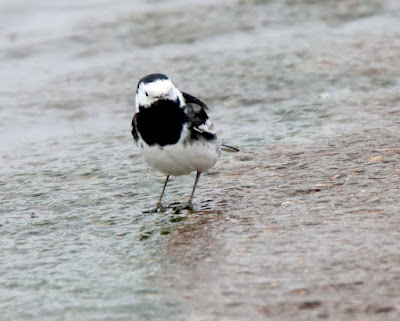FLY FLATTS Out in the early morning mist, 2 Whooper Swans.
Sun up, after walking the west bank.
THORNTON MOOR Two pair Goldeneye present, male
male and female.
A deep swell
4 noisy Oystercatchers
2 distant male Goldeneye
LBB gull
Herring gull
ad LBB
Herring
Back to FLY FLATTS, due to blog having a mind of its own.
Lapwing in spring primary moult. Very few species perform this moult.
Male Pied Wagtail back in the boatyard.
Barnacle always has plenty to say.
Ringed Plovers sheltering from the wind.
Barny with its mate
4 Oystercatchers present. possible the TMR 4.
Peering through the mist as I arrived I could just make out 2 Whooper Swans way over in the NW corner of the water which was a good start off to the morning. By the time I,d walked the length of the west bank the sun was out making the swans look majestic on the blue water.
Scoping the far bank the first 2 Redshank had returned, part hidden in the grass bank of the NE corner whilst 4 noisy Oystercatchers were mobile throughout the morning.
The 2 Ringed Plover were keeping down out of the cold wind whilst 2 Raven overhead didnt seem to bother along with several Lapwings and Curlews.
The Barnacle goose and its Canada mate are always together now , either on the water or in the boatyard along with around another 200 Canadas.
A great shortage of small passerines with no Stonechat or Reed Bunting at the moment and only a handful of Meadow Pipits. The first juv Wheatears should be arriving within a weeks time.
Thornton Moor mid afternoon was very windy but bright with around 150 Herring gulls on the water along with 15 LBBs and a few small gulls.
The 2 pair of Goldeneye were still present along with the 5 Goosander ,(2 males), and 4 Oystercatchers.
Lapwings and Curlews were everywhere though the large flock of Curlew had dispersed. Wheatears are usually a bit earlier at this location but a check of the walls and quarry failed to turn anything up. Ring Ouzels usually show up in good time also in this area. Back in 12/11/2000 we found a very rare Ring Ouzel, (Turdus Torquatus Amicorum), of the Asian/ East Turkish race on the banking, which coincided with strong easterlies bringing in several far eastern species. The bird, showing a very broad neck band and brilliant white fringes on coverts and flight feathers in addition to no scales on its body plumage, was watched by DCB, HC, MD, SJ and myself.
On the way home a check of all the usually productive Thornton fields failed to produce the Med gull or very few gulls at all, possibly due to the strength of the wind and change in direction.
BS













































